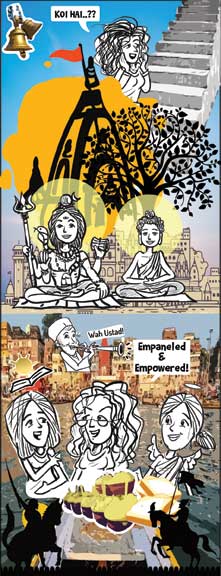Devika Nadig
The journey of a thousand miles began with the launch of Shikshangan in 2008 and continued much beyond this distance by covering the length, breadth and depth of our country. In the course of these journeys and the many interactions they brought, Vijay and I learned from individuals, communities and multiple stakeholders in the education landscape. I reckoned it would make sense to share these experiences with a wider audience, with the aim of documentation and a hope that these will both entertain and educate. Each tour was unique and I hope my storytelling skills will amuse and not lose – readers.
Some of our travels took us to ancient temple towns, creating the opportunity for encounters that made me confront my own ambiguous relationship with religion, but in the process, led me to interesting discoveries – about myself and my teaching practice.
Sixth Stop: (Part 1) Kashi Vishweshwar – Sunbeam Group of Schools – 2015
If you cannot sacrifice sleep – do not venture forth into Varanasi!
Winning CBSE empanelment was a jewel in the Crown for Coaches, with the new government at the Centre in 2014. Stories of how just mettle and credence is not rewarded, that you need briefcases of stashed cash to win this crown did the rounds in hushed whispers during prestigious conferences. We decided to call the bluff on rumours and applied through a gruelling tendering process that seemed worth burning hours on, when Shikshangan was empaneled along with few others. This tale picks up from our first visit as empaneled trainers to Kashi – Benaras – Varanasi, whichever way you like to address this 3000 year old, living, ancient city.

I met the demure ‘You’ve got to give me a second glance’ compelling presence of Amrita Burman, Director, Sunbeam Group of Schools sometime in 2012 at a conference, with hurriedly exchanged cards and a promise of – Hey, we must work together – and kept in touch for a couple of years never letting go of our tryst to meet. The year 2015 saw Vijay and me in her office at Sunbeam Lahartara – an area of Benaras where the poet Sant Kabir was born and raised. Sunbeam hosted a School Leadership Program under CBSE and our module on Change Management caught the attention of all school heads from around Varanasi. Over the years we developed buddy bonds with a few participants from that course, specially Ashoo Kalra, a seraphic soul who continues to help us celebrate Varanasi in its myriad vitalizing forms.
We had checked in at the Benaras Club (1848), its foyer displaying charcoal sketches of legends from the world of music, literature and politics – who were raised on the banks of the Ganga – Ustad Bismillah Khan, Munshi Prem Chand, Madan Mohan Malviya and many other humbling names… Benaras is about all that is superlative for the soul, including the great edifice of education – Benaras Hindu University. Silks and brocades, perfumes and wooden toys, carpets and muslin; everything revolves around the grandiose Ganges, and her 84 mystifying ghats …. You see life and death juxtaposed with each other, both being celebrated with equal fervor.
Benaras brings the burden of choice. If you think you are in the city of Shiva, you are soon reminded that Buddha was here around 528 BCE for his first sermon at Sarnath. Just as you make up your mind to take a boat ride on the Ganges at 6 pm to witness the visual treat of a resplendent Ganga Aarti at Dashashwamedh Ghat, there is an imperceptible nudge to opt instead for the ‘Subah Benaras’, a boat ride at 4 am for welcoming the break of dawn on Assi Ghat… We chose the latter on our first trip , led by the desire for solitude, and giving in to the temptation of some early morning street breakfast.
Waking to unmistakable excitement as you hear a knock on your door at 3.30 am, you open yourself to the freezing winter air; take a drive into Chowk, scamper down the empty steps of the ghat at that hour, and step into an unsteady boat which leaves its anchor to embrace the Ganges. The boatman is all wrapped in woollens, his coarse hands cracking and worn as he rows the oars, yet with a song on his lips as his boat sways gently to the chants of distant bells of awakening shrines; the silence … the dip of oar into water … water dripping off the oars between strokes. This stays with you as you take in the breathless beauty of the river and the endless ghats. The boat anchors at Assi Ghat at the peep of day, to partake of the aarti at Assi , where the air is saturated with prayers and dreams. Subah Benaras becomes an ethereal experience as the sun rises on the waters, turning the Ganges into a florid orange.
Expectancy of a smooth visit inside the Kashi Vishwanath (built-1780 by Ahilyabai Holkar of Indore), was fulfilled soon after – courtesy, the Sunbeam group. Vijay waited patiently outside as I was whisked inside the maze of lanes leading up to the shrine of Shiva and found myself in the solemn and silent inner sanctum, where the priest generously loaded my palm with a Chandan lep as a blessing. Feeling rather privileged, I moved back through the maze and was astonished to encounter pilgrims taking some of the paste off my palms! Hey! Make your own inroads, guys!
Street food here is distinctive… delectable ‘melt in the mouth’ Ceaser Toast of Laxmi Tea House, just behind Chowk Thana near the temple and ‘Mallaiyyo’ a winter delicacy available for just two cold morning hours. Discovering local life with Ashoo made this gastronomical journey delightful, as we gorged on white butter toasts roasted in a sizzling tandoor which doubled up as a heater for hungry souls in the winter chill. Fashionable Keto and Atkin diets need to be left behind in your flamboyant flats, when you hit the desi streets of Kashi.
The last evening took us back to the Ganges …this time we chose a heritage property ‘Guleria Kothi’, tastefully refurbished to suit the well-heeled wayfarers from other shores, with no other entrance to it except from the river by boat. Immersing in the evening we took in the grandeur of the ghats with the gleam of secret lights coming up in niches and crevices everywhere as dusk fell, the sweeping view revealing a Ganesh Ghat of Maharashtra cheek by jowl with the Kothi!

It said ‘Peshwas in 1807 AD’. Once more Vijay brought to the fore the Maratha history and we talked about how Peshwas were banished from Shaniwar Wada in Pune to UP’s Bithoor, after the Anglo-Maratha war of the late 1700s…. Attracted enough to abandon my coffee, I walked towards this enigma and found an ancient staircase of worn-out, shining stone going up to a mysterious nowhere. As if on a string tugging at my heart, I walked up to find a locked entrance and called out the filmy, “Koi hai?”
Rapid footsteps and the door was opened by a priest partially blocking a Ganesh idol behind him, moving away to expose it as made of radiant coral-catching the sunset on the river, and casting a sombre orange reflection inside. The walls had portraits of generations of Peshwas. The triumph of history is tracing the roots – ancient and alive – of our present condition in the world. The triumph of self-understanding is tracing the roots of the influences that make us who we are … I grew up being told that my ancestors were priests in the Peshwa reign….
Language binds you more than religion, so we spontaneously broke into Marathi. When I looked out at the Ganges from this space of my cultural roots, I felt I had been here long before.
The author has been engaged in the domain of school education for the past three decades. She is the co-founder of Shikshangan Education Initiatives, Pune, along with Vijay Gupta. The scope of their work includes teacher development by sharpening pedagogical skills and working with school leaders on their instructional and organizational leadership skills. She can be reached at devika@shikshangan.org.
